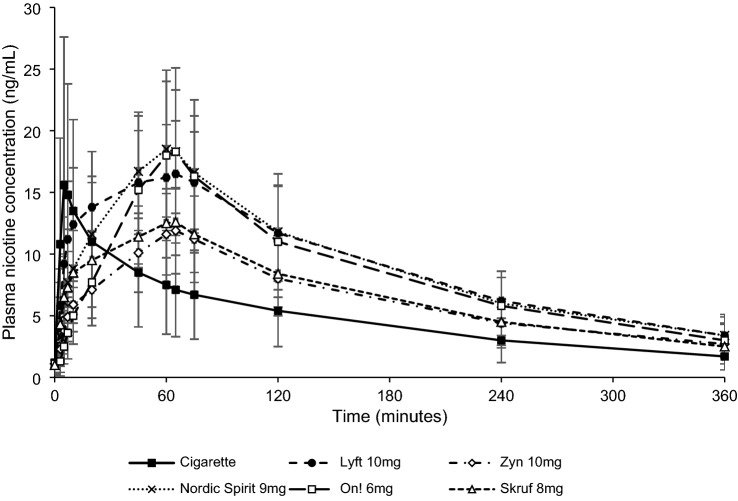FAQ
0. Does nicotine cause cancer?
No. Unfortunately, nearly 80% of doctors worldwide mistakenly believe it does, thwarting efforts to help one billion smokers quit. [WHO, Cancer Research UK]
1. Who are you?
Who we are not is Big Tobacco! However, we use the same ISO/GMP certified supply chain as some of them, ensuring high-end quality. Big Tobacco owns the majority of major nicotine pouch brands (e.g. British American Tobacco — Velo/Lyft, Phillip Morris — Zyn, On!), and BINGBONG wants to disrupt this inequality and bring power back to the dude-guy.
2. Are nicotine pouches safe?
Public health experts have concluded that whilst nicotine is an addictive substance and not completely risk free, it is not the primary cause of smoking-related diseases; inhalation of tobacco smoke is (RCP, 2016). Smoking cigarettes is therefore considered the most harmful form of nicotine consumption. [1]
One study found nicotine pouches had 99% less toxicants than a traditional cigarette:
In a comparison based on an assessment of smoke from a scientific standard reference cigarette (approximately 9 mg tar) and components released during use of [a comparable] nicotine pouch product, in terms of the average of the 9 harmful components the World Health Organization recommends to reduce in cigarette smoke. [2][3]
Video Reference: Nicotine Pouches: A Brief History
3. How do I use nicotine pouches? How long do they last?
To open container, break plastic seal on side;
Take out pouch and place under top lip;
BINGBONG’s semi-wet format allows for a long, even release of nicotine and flavoring for up to 60 minutes;
When flavor is gone, dispose of in trash or in catch-lid.
4. What’s in BINGBONG nicotine pouches?
Nicotine pouches typically contain nicotine, flavorings, sweeteners and plant-based fibers. More specifically, BINGBONG contains:
Microcrystalline Cellulose (filler/texture),
Pharma-grade synthetic nicotine,
Mannitol, Ace K (sweeteners),
Sodium Bicarbonate, Sodium Carbonate (pH buffers),
Flavoring.
5. What type of nicotine is used in BINGBONG pouches?
Nicotine is either tobacco or synthetic-derived; BINGBONG uses synthetic nicotine. Moreover, nicotine is divided into salt-base and free-base. While more expensive, BINGBONG uses S-isomer, salt-based synthetic nicotine to reduce TSNAs (cancer causing chemicals in tobacco derived nicotine) to reduce irritation and optimize the nicotine delivery mechanism.
6. What are the benefits of using nicotine pouches?
Nicotine Pouches have many benefits when compared to smoking and vaping, including:
100% tobacco-free — do not contain the numerous known toxins/TSNAs in cigarettes;
no combustion — the leading reason as to why smoking is harmful;
do not discolor your teeth and clothing;
no second-hand effect — do not emit odors, smoke or vapor;
discreet — essentially invisible when compared to other cessation products.
7. Are there risks to using nicotine pouches?
Nicotine pouches are not risk-free as they contain nicotine, an addictive chemical. Please be aware of the following risks [4]:
nicotine addiction — if not addicted to other tobacco/nicotine products, this product is not for you;
nausea and dizziness — take out if occurs/lower MG usage or quit;
gum recession — nicotine can inhibit blood flow — do not place pouch in same spot repeatedly;
hiccups or difficulty sleeping — nicotine is a stimulant — reduce dosage or quit or try not to use within 4h of bedtime.
8. Can they help me quit smoking/vaping/snus?
Unlike pharma-made gum and patches, nicotine pouches are not currently approved as Nicotine Replacement Therapy (NRT). However, some people may find them helpful to quitting smoking/vaping.
If your goal is to quite smoking, the below videos may provide helpful information:
What is the Single Best Thing You Can Do to Quit Smoking?
Nicotine’s Effects on the Brain & Body & How to Quit Smoking or Vaping | Huberman Lab Podcast #90
9. How does the nicotine strength/absorption of pouches compare with traditional cigarettes or vaping?
Traditional cigarettes contain ~10-12 mg and reach maximum nicotine absorption more quickly than nicotine pouches. Pouches, however, maintain a longer plasma nicotine concentration. The nicotine absorption rate, of course, varies by product and nicotine strength. [5]
10. How do nicotine pouches differ from traditional snus?
Traditional snus contains Tobacco, while nicotine pouches do not. However, many people refer to both as “snus”.
11. How many calories in a BINGBING pouch?
< 1 calories. The food-grade sweeteners used are calorie-free.
12. How does the nicotine concentration compare to e-cigs and cigarettes?
The below comparison assumes a 12 mg cigarette, 10 (3.5s) puffs/h and 1 nicotine pouch per hour. This is a rough estimate as there are myriad factors that affect nicotine absorption and tolerance.
REFERENCES:



